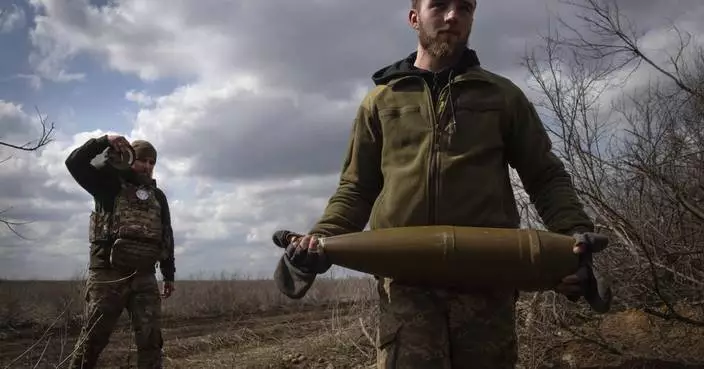In the nearly four years since the Pentagon announced it was opening all combat jobs to women , at least 30 have earned the Army Ranger tab, two have graduated Marine infantry school and three have passed the grueling initial assessment phase for Green Beret training.
Their numbers are small, but their completion of some of the military's most arduous physical and mental courses has raised an intriguing scientific question: Who are these "hyperfit" women and what makes them so competitive?
Army medical researchers hope to uncover answers in a just-launched voluntary study.
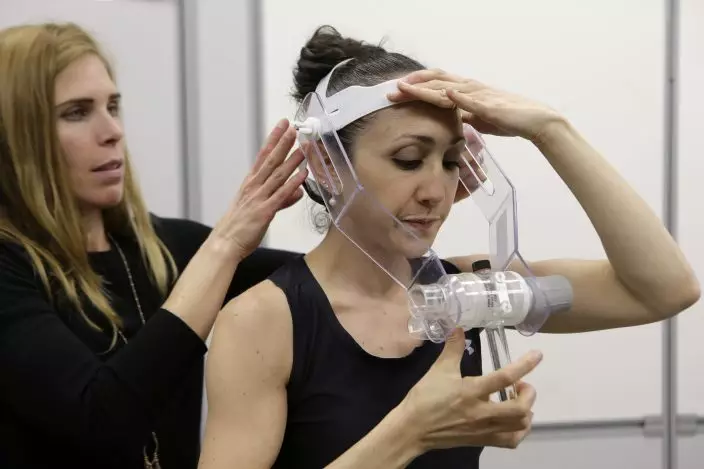
In this April 23, 2019 photo, nutritional physiologist Holly McClung, left, assists research scientist Leila Walker, right, as they demonstrate equipment designed to evaluate fitness levels of female soldiers, not shown, who have joined elite fighting units such the Navy Seals, at the U.S. Army Research Institute of Environmental Medicine, at the U.S. Army Combat Capabilities Development Command Soldier Center, in Natick, Mass. (AP PhotoSteven Senne)
"We're really interested in those elite women that are the first to make it through physically demanding training," said Holly McClung, a nutritional physiologist at the Army Research Institute of Environmental Medicine in Massachusetts. "The real point of the study is to characterize this unique cohort of women that has made it through these traditionally male trainings."
During early debate on the move to open all combat jobs to women, military leaders raised questions about whether women were up to the jobs or if putting them on the front lines would make units less capable. The Marine Corps sought an exemption to keep some combat jobs closed for precisely that reason, but they were overruled by then-Defense Secretary Ash Carter.
Women, however, have increasingly made it through the nine-week Ranger course, and the numbers of those trying out for other special operations jobs is slowly inching up. The courses all encompass a number of phases and run from about nine weeks to a year or two for the most elite commando jobs.
They involve a wide array of grueling physical fitness tests, combat water survival, day and night land navigation, long road marches carrying heavy packs, extended patrols through various climates, and extensive mental, psychological and leadership testing.
The goal, said McClung, is to identify the attributes — whether mental, physical or psychological — that help the women succeed. By unlocking those secrets, maybe they can help other women compete for the same jobs.
In a small basement office at this Army base in Natick, Massachusetts, McClung and Julie Hughes, a research physiologist, are setting up a treadmill that's linked to a nearby computer. They plan to have the women use a mask and breathing apparatus to calculate each participant's vo2 Max score, a key fitness indicator. The score measures how many millimeters of oxygen used per kilogram of body weight per minute; in other words, how much oxygen is being used at a person's peak exercise rate.
An average sedentary person may have a score of about 30. Top athletes — runners and cyclists — can score in the 80s.
The plan, at this point, is to have the military women come to Natick, in groups of two or three, and go through a range of tests over three days to identify biological and physiological markers that help define them as hyperfit. Having several tested at the same time, McClung said, will make it more interesting and encourage competition.
"This is a unique historical time," said Hughes. "There's this group of women who made it through the training so we want to get them to at least do these observational investigations to explore what makes them unique."
That breathing test, along with others on their blood, calcium and iron levels, as well as bone density scans and exercise programs will be used to determine the women's physical fitness. Other written tests and interviews will evaluate their mental toughness and psychological resilience.
The women will take three psychological exams that are designed to determine their grit, hardiness and resilience.
For example, the military version of the resilience test lists statements and asks people to determine on a scale of one to five if the statement is definitely or mostly false, "don't know" or mostly or definitely true. Some examples of the statements are: I enjoy most things in life; I often feel helpless; I like to have a lot of structure in my life; I carefully plan just about everything I do; it bothers me when my daily routine gets interrupted; and my successes are because of my effort and ability.
Mark Esper, President Donald Trump's nominee for defense secretary, said the study will be important to help understand fitness and perhaps reduce injury rates. He was serving as Army secretary when this study was first broached.
"My belief is it's grit — grit gets them through this," he said. "You have to have a certain level of athletic ability, but they take it to an extraordinary level. These women are tough."
McClung said she received word on July 12 that the final study was approved. She said that if more women graduate from any of the military training courses, they could be added to the study.
McClung and Hughes also said they hope to be able to compare the women's results with similar testing on men.
It will be up to the women to decide if they want to participate. But based on feedback from some of the women, they think a number of them will want to take part in the study.
"I think we're encouraged that they'll be willing to participate," Hughes said. "They want to be counted."
KYIV, Ukraine (AP) — A big, new package of U.S. military aid will help Ukraine avoid defeat in its war with Russia. Winning will still be a long slog.
The arms and ammunition in the $61 billion military aid package should enable Ukraine to slow the Russian army's bloody advances and block its strikes on troops and civilians. And it will buy Ukraine time — for long-term planning about how to take back the fifth of the country now under Russian control.
“Ultimately it offers Ukraine the prospect of staying in the war this year,” said Michael Clarke, visiting professor in war studies at King’s College London. “Sometimes in warfare you’ve just got to stay in it. You’ve just got to avoid being rolled over.”
The U.S. House of Representatives approved the package on Saturday after months of delays by some Republicans wary of U.S. involvement overseas. It was passed by the Senate on Tuesday, and President Joe Biden said he would sign it Wednesday.
The difference could be felt within days on the front line in eastern and southern Ukraine, where Russia’s much larger army has been slowly taking territory against massively outgunned Ukrainian forces.
The aid approval means Ukraine may be able to release artillery ammunition from dwindling stocks that it has been rationing. More equipment will come soon from American stocks in Poland and Germany, and later from the U.S.
The first shipments are expected to arrive by the beginning of next week, said Davyd Arakhamia, a lawmaker with Ukrainian President Volodymyr Zelenskyy’s Servant of the People party.
But opposition lawmaker Vadym Ivchenko, a member of the Ukrainian parliament’s National Security, Defense and Intelligence Committee, said logistical challenges and bureaucracy could delay shipments to Ukraine by two to three months, and it would be even longer before they reach the front line.
While details of the shipments are classified, Ukraine’s most urgent needs are artillery shells to stop Russian troops from advancing, and anti-aircraft missiles to protect people and infrastructure from missiles, drones and bombs.
What’s coming first is not always what front-line commanders need most, said Arakhamia, the Ukrainian lawmaker. He said that even a military giant like the U.S. does not have stockpiles of everything.
“The logic behind this first package was, you (the U.S.) finds our top priorities and then you see what you have in the warehouses,” Arakhamia said. “And sometimes they do not match.”
Hope for future breakthroughs for Ukraine still hangs on more timely deliveries of Western aid, lawmakers acknowledge.
Many experts believe that both Ukraine and Russia are exhausted by two years of war and won’t be able to mount a major offensive — one capable of making big strategic gains — until next year.
Still, Russia is pushing forward at several points along the 1,000-kilometer (600-mile) front, using tanks, wave after wave of infantry troops and satellite-guided gliding bombs to pummel Ukrainian forces. Russia is also hitting power plants and pounding Ukraine’s second-largest city, Kharkiv, which is only about 30 kilometers (some 20 miles) from the Russian border.
Ivchenko said the goal for Ukraine’s forces now is to “hold the line” until the bulk of new supplies arrive by mid-summer. Then, they can focus on trying to recapture territory recently lost in the Donetsk region.
“And probably ... at the end of summer we’ll see some movement, offensive movement of the Ukrainian armed forces,” he said.
Some military experts doubt Ukraine has the resources to mount even small offensives very soon.
The U.S. funding “can probably only help stabilize the Ukrainian position for this year and begin preparations for operations in 2025,” said Matthew Savill, director of military sciences at the Royal United Services Institute, a think tank.
In the best-case scenario for Ukraine, the American aid will give commanders time to reorganize and train its army — applying lessons learned from its failed summer 2023 offensive. It may also galvanize Ukraine’s allies in Europe to increase aid.
“So this just wasn’t about Ukraine and the United States, this really affected our entire 51-country coalition,” said U.S. Congressman Bill Keating, a Democrat who visited Kyiv on Monday as part of a four-member congressional delegation.
Zelenskyy insists Ukraine's war aim is to recapture all its territory from Russia — including Crimea, seized illegally in 2014. Even if the war ultimately ends through negotiation, as many experts believe, Ukraine wants to do that from as strong a position as possible.
Whatever happens on the battlefield, Ukraine still faces variables beyond its control.
Former U.S. President Donald Trump, who seeks to retake the White House in the November election, has said he would end the war within days of taking office. And the 27-nation Europe Union includes leaders like Hungarian President Viktor Orbán and Slovakian Prime Minister Richard Fico, who have opposed arming Ukraine.
Ukraine’s allies have held back from supplying some arms out of concern about escalation or depleting their own stocks. Ukraine says that to win the war it needs longer-range missiles it could use for potentially game-changing operations such as cutting off occupied Crimea, where's Russia's Black Sea fleet is based.
It wants Army Tactical Missile Systems, known as ATACMs, from the U.S. and Taurus cruise missiles from Germany. Both governments have resisted calls to send them because they are capable of striking targets deep within Russian territory.
The new bill authorizes the president to send Ukraine ATACMS “as soon as practicable.” It's unclear what that will mean in practice.
Sometimes, promised weapons have arrived late, or not at all. Zelenskyy recently pointed out that Ukraine is still waiting for the F-16 fighter jets it was promised a year ago.
Meanwhile, Russia is using its advantage in troops and weapons to push back Ukrainian forces, perhaps seeking to make maximum gains before Ukraine's new supplies arrive.
For weeks it has pummeled the small eastern city of Chasiv Yar, at the cost of 900 soldiers killed and wounded a day, according to the U.K. Ministry of Defense.
Capturing the strategically important hill town would allow them to move toward Sloviansk and Kramatorsk, key cities Ukraine controls in the eastern region of Donetsk. It would be a significant win for Russian President Vladimir Putin, who Western officials say is bent on toppling Ukraine’s pro-Western government.
Russian pressure was aimed not just at gaining territory, but on undermining Zelenskyy and bolstering critics who say his war plan is failing, said Clarke of King's College London.
The U.S. aid package decreases the likelihood of a political crisis in Ukraine, and U.S. Speaker Mike Johnson deserves credit for pushing it through Congress, he said.
"He held history in his hands,” Clarke said.
Follow AP’s coverage of the war in Ukraine at https://apnews.com/hub/russia-ukraine

From left, U.S. representatives Nathaniel Moran, R-Tx, Tom Kean Jr, R-NJ, Bill Keating, D-Mass, and Madeleine Deane, D-Pa, talk to journalists during a joint news conference outside Saint Michael cathedral in Kyiv, Ukraine, Monday, April 22, 2024. A newly approved package of $61 billion in U.S. aid may prevent Ukraine from losing its war against Russia. But winning it will be a long slog. (AP Photo/Francisco Seco)
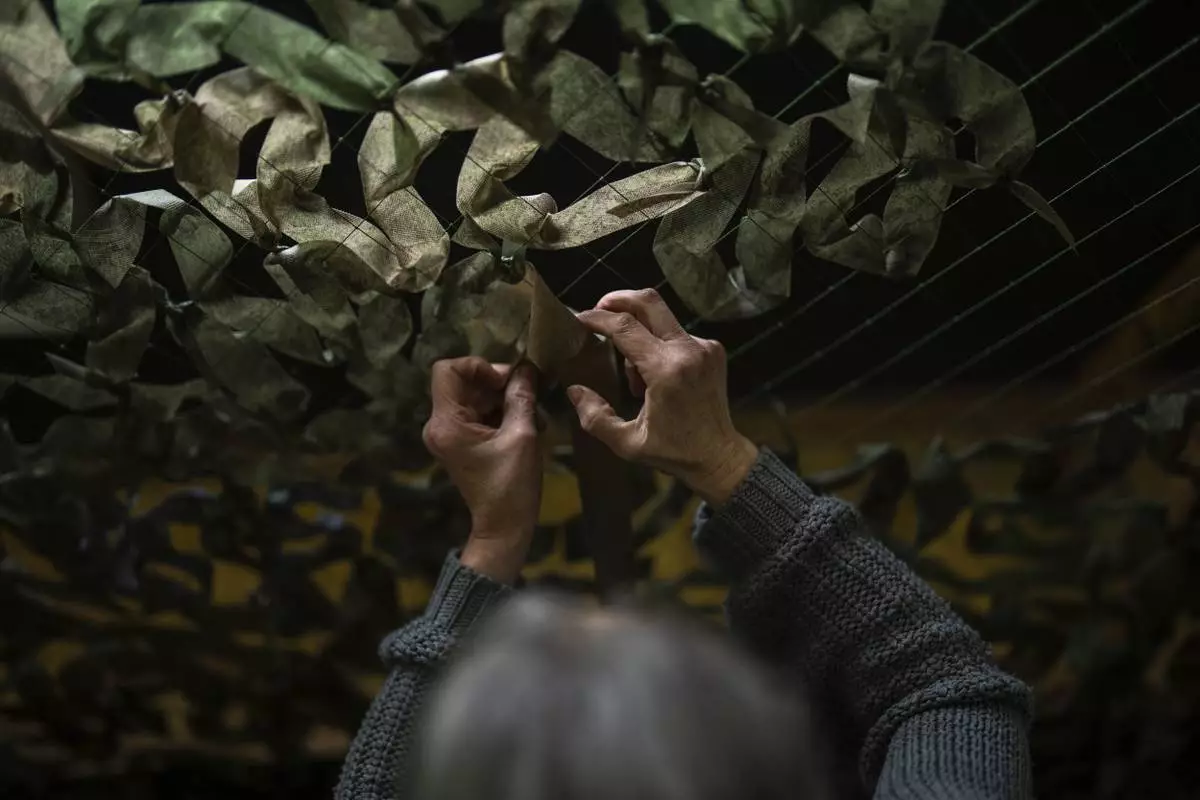
A volunteer makes a camouflage net at a facility producing material for Ukrainian soldiers in Kyiv, Ukraine, Monday, April 22, 2024. A newly approved package of $61 billion in U.S. aid may prevent Ukraine from losing its war against Russia. But winning it will be a long slog. (AP Photo/Francisco Seco)
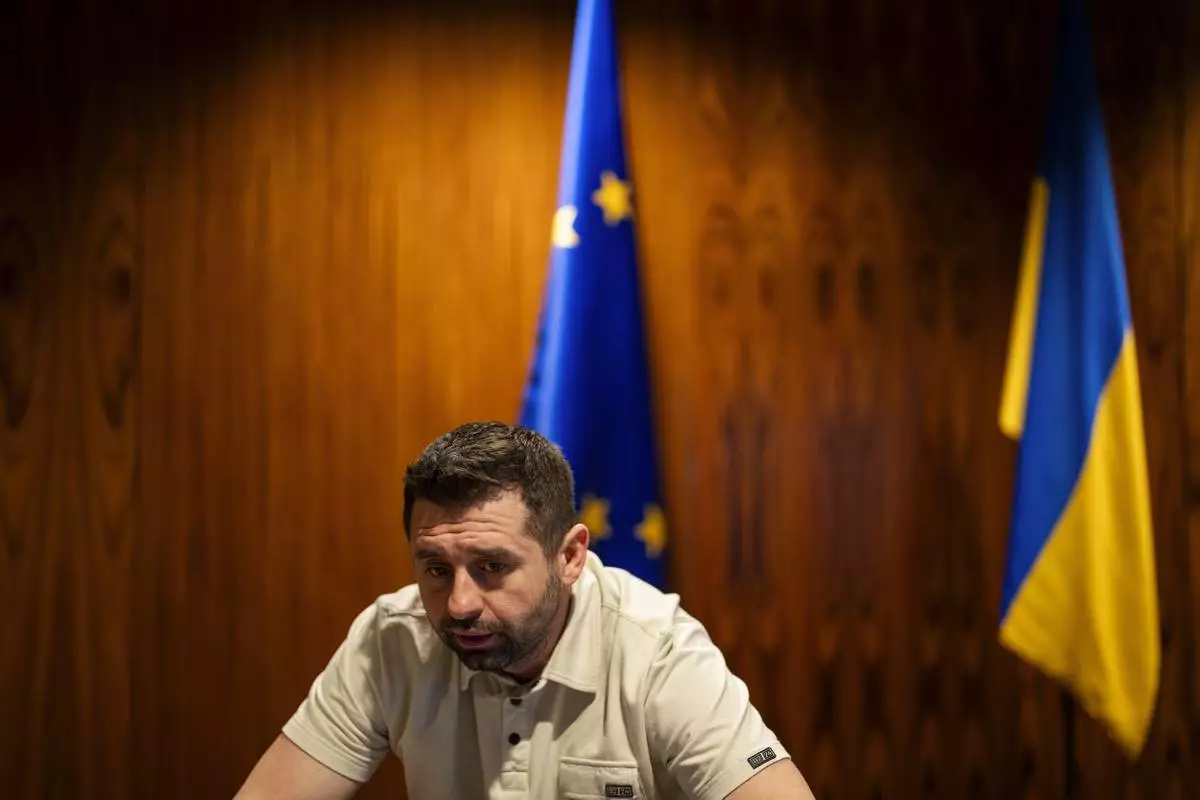
Davyd Arakhamia, a lawmaker with Ukrainian President Volodymyr Zelenskyy's Servant of the People party, talks during an interview with Associated Press in Kyiv, Ukraine, Monday, April 22, 2024. (AP Photo/Francisco Seco)

A woman rallies to raise awareness on the fate of Ukrainian prisoners of war in Kyiv, Ukraine, Sunday, April 21, 2024. (AP Photo/Francisco Seco)
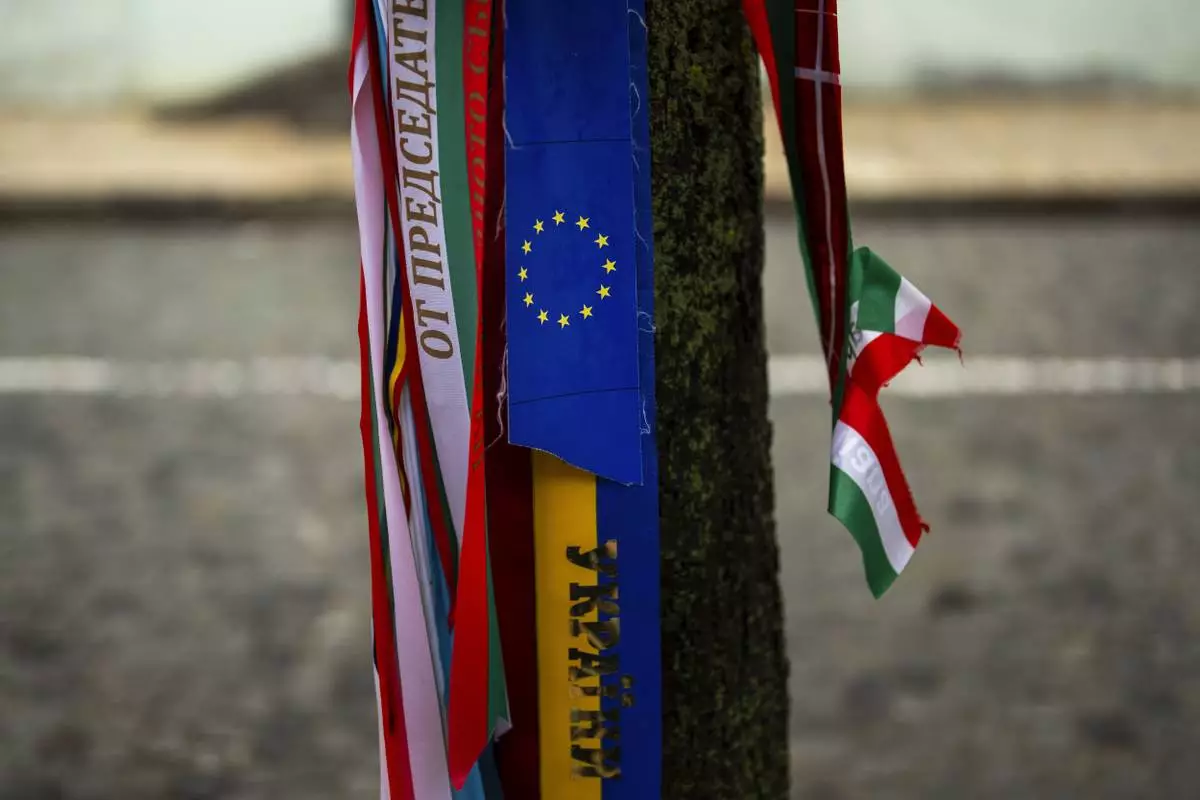
Ribbons with the colors of the European Union and Ukraine are attached to a tree next to memorial wall of Ukrainian soldiers killed during the war in Kyiv, Ukraine, Monday, April 22, 2024. (AP Photo/Francisco Seco)
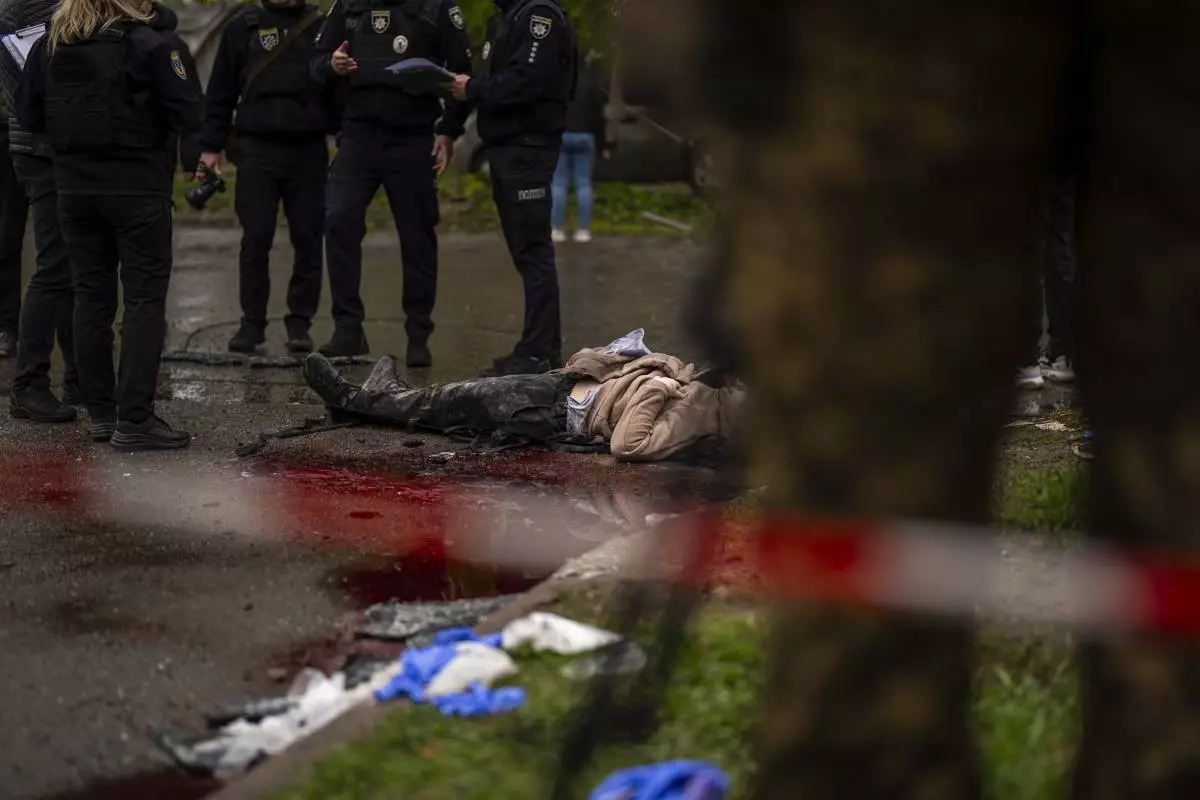
The body of a woman killed by Russian bombardment in Chernihiv, Ukraine, Wednesday, April 17, 2024. (AP Photo/Francisco Seco)

Soldiers carry the coffins of two Ukrainian army sergeants during their funeral in Lviv, Ukraine, Tuesday, April 16, 2024. (AP Photo/Francisco Seco)














